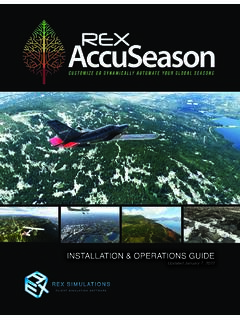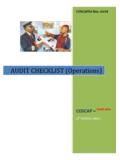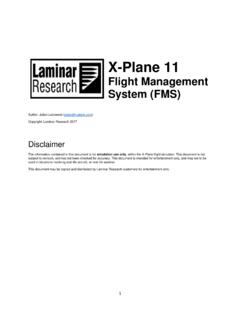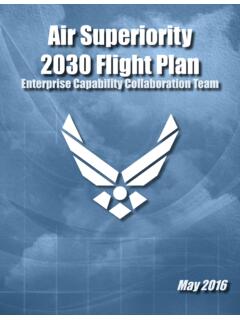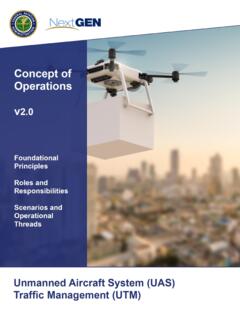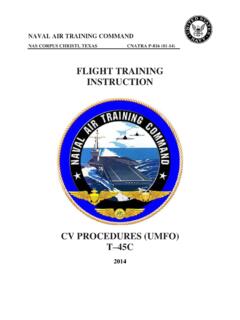Transcription of Remote Pilot ‒ Small Unmanned Aircraft Systems Airman ...
1 FAA-S-ACS-10B Department of Transportation Federal Aviation Administration Remote Pilot Small Unmanned Aircraft Systems Airman Certification Standards April 2021 Flight Standards Service Washington, DC 20591 Acknowledgments The Department of Transportation, Federal Aviation Administration (FAA), Office of Safety Standards, Regulatory Support Division, Airman Testing Branch, Box 25082, Oklahoma City, OK 73125 developed this Airman Certification Standards (ACS) document with the assistance of the subject matter experts in the area related to Small Unmanned Aircraft Systems (UAS).
2 Availability This ACS is available for download from Please send comments regarding this document using the following link to the Airman Testing Branch mailbox: Material in FAA-S-ACS-10B is effective April 6, Foreword The Federal Aviation Administration (FAA) publishes the Remote Pilot Small Unmanned Aircraft Systems (UAS) Airman Certification Standards (ACS) document to communicate a means to evaluate the aeronautical knowledge standards for certification knowledge testing for a Remote Pilot Certificate with a Small UAS FAA views the ACS as the foundation of its transition to a more integrated and systematic approach to Airman certification.
3 The ACS is part of the Safety Management System (SMS) framework that the FAA uses to mitigate risks associated with Airman certification training and testing. Specifically, the ACS, associated guidance, and test question components of the Airman certification system are constructed around the four functional components of an SMS: Safety Policy that defines and describes aeronautical knowledge, risk management, and flight proficiency as integrated components of the Airman certification system; Safety Risk Management processes through which both internal and external stakeholders identify changes in regulations, safety recommendations, or other factors.
4 These changes are then evaluated to determine whether they require modification of Airman testing and training materials; Safety Assurance processes to ensure the prompt and appropriate incorporation of changes arising from new regulations and safety recommendations; and Safety Promotion in the form of ongoing engagement with both external stakeholders ( , the aviation training community) and FAA policy divisions. Rick Domingo Executive Director, Flight Standards Service ii Revision History Document Description FAA-S-ACS-10 Remote Pilot Small Unmanned Aircraft Systems Airman Certification Standards Revision Date July 2016 FAA-S-ACS-10A Remote Pilot Small Unmanned Aircraft Systems (Certification and Recurrent Knowledge Testing)
5 Airman Certification Standards June 2018 FAA-S-ACS-10B Remote Pilot Small Unmanned Aircraft Systems Airman Certification Standards April 2021iii Major Enhancements to Version FAA-S-ACS-10B Action Section Introduction Updated Description Airman Certification Standards Concept subsectionUpdated Using the ACS subsection References Updated Task references, as necessary Area of Operation I, Regulations Added Knowledge elements K6, K7, and K8 to Task A, General Added Knowledge elements K23, K24, K25, K26, K27, and K28 to Task B, Operating Rules Added Task E, operations Over People Added Task F, Remote Identification (RID) Area of Operation II, Airspace Added Knowledge elements K6, K7, K8, K9, and K10 to Task B, Airspace Classification and Operating Operational Requirements Requirements Area of Operation V, operations Added Knowledge element K8 to Task B, Airport operations Added Knowledge elements K6 and K7 to Task C, Emergency Procedures Added Knowledge elements K8 and K9 to Task E, Physiology Added Knowledge elements K6 and K7 to Task F, Maintenance and Inspection Procedures Appendices Updated Appendix 1.
6 Certification Knowledge Test, Eligibility, and Testing Centers Updated Appendix 3: Airman Knowledge Test Report for Certification Updated Appendix 4: References iv Table of Contents Introduction Airman Certification Standards Concept 1 Using the ACS 1 Rules3 Pilot Certification with an sUAS Rating5 Over People7 Identification (RID)8 Classification and Operating Classification9 Operational Requirements10 of Weather11 of Weather on Performance12 and and Performance13 Communications Procedures14 Operations15 Procedures16 Decision-Making17 and Inspection Procedures19 Appendices Table of Contents 20 v
7 Introduction Airman Certification Standards Concept The goal of the Airman certification process is to ensure the applicant possesses knowledge consistent with the privileges of the Remote Pilot Certificate with a Small Unmanned Aircraft Systems (sUAS) rating, as well as the ability to manage the risks of flight in order to act as a Remote Pilot -in -command (PIC). In fulfilling its responsibilities for the Airman certification process, the Federal Aviation Administration (FAA) Flight Standards Service (AFS) plans, develops, and maintains materials related to Airman certification testing.
8 These materials include several components. The FAA knowledge test measures mastery of the aeronautical knowledge areas listed in Title 14 of the Code of Federal Regulations (14 CFR) parts 89 and 107. Other materials, such as Airman knowledge testing supplements in the FAA-CT-8080 series and FAA online training, provide guidance to applicants on aeronautical knowledge and risk management. The FAA recognizes that safe operations in today's complex National Airspace System (NAS) require a more systematic integration of aeronautical knowledge and risk management.
9 The FAA further recognizes the need to more clearly calibrate knowledge and risk management to the level of the Remote Pilot Certificate with an sUAS rating. The ACS integrates the elements of knowledge and risk management in 14 CFR parts 89 and 107 for a Remote Pilot Certificate with an sUAS rating. It thus forms the comprehensive standard for what an applicant knows and considers to successfully complete each Task tested on the knowledge test. In keeping with this integrated and systematic approach, the knowledge Task elements of each Task identify what the applicant should know and understand for sUAS operations conducted under 14 CFR parts 89 and 107.
10 The applicant demonstrates this understanding by passing the knowledge test. Using the ACS This Remote Pilot ACS includes Areas of Operation and Tasks for the issuance of a Remote Pilot Certificate with an sUAS rating in accordance with 14 CFR part 107, section Element codes in the ACS divide into four components. For example: : UA = ACS ( Unmanned Aircraft Systems ) I = Area of Operation (Regulations) B = Task (Operating Rules) K10 = Knowledge Element (Visual line of sight (VLOS) Aircraft operations .) At the conclusion of a knowledge test, an applicant is given their Knowledge Test Report (KTR). The KTR lists the applicant's name, date of the test, the type of test, a unique test identification number, the score and ACS Codes for questions that were answ ered incorrectly.











